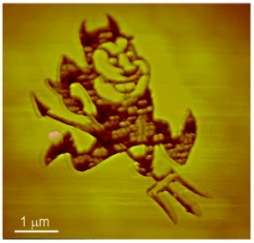Micro Sparky: Engineering the tiniest Sun Devil

(PhysOrg.com) -- An Arizona State University engineering student may have found the tiniest - yet most cleverly inventive - way to show school spirit.
Adam Burke, a doctoral student in the School of Electrical, Computer and Energy Engineering, part of ASU’s Ira A. Fulton Schools of Engineering, created “Micro Sparky,” a microscopic etching of Sparky, the ASU Sun Devil mascot. Micro Sparky measures at slightly less than five microns in height. That’s smaller than a human red blood cell, which typically measures at six to eight microns - too small be seen without an optical microscope.
Burke describes the way he made Micro Sparky as a process similar to how an artist would etch patterns into glass or stone - only on a microscopic scale.
He fashioned the image by using electron beam lithography to etch it into a material called indium arsenide placed on top of another material called indium aluminum antimonide. Electron beam lithography was used to create the Sparky pattern by drawing it onto the surface on the materials with a directed beam of electrons. The process is achieved with a device that can emit streams of electrons. Magnets in the column through which the beam travels deflect electrons in a way that enables them to define patterns.
“You can control this process like the way you control your hand when you draw a picture,” says Burke, whose academic adviser is electrical engineering professor David Ferry, an ASU Regents’ Professor.
The image was further developed using a process similar to how a photographic image is developed from film in a chemical bath.
Once the pattern was developed, Burke used a chemical etchant to eat into the material in the exposed surface - and Micro Sparky was born.
The advanced materials Burke was able to use came from the U.S. Naval Research Laboratories. Its researchers produced the indium arsenide on indium aluminum antimonide material for their work to develop advanced microwave transistors (transistors that operate at higher frequencies in these rare materials).
Naval researchers gave some of the material to Burke to help him experiment with one of the devices he developed in his doctoral electrical engineering program.
His accomplishments at ASU have helped Burke earn a position as a senior research assistant in the College of Physics at the University of New South Wales in Australia.
Provided by Arizona State University (news : web)
















